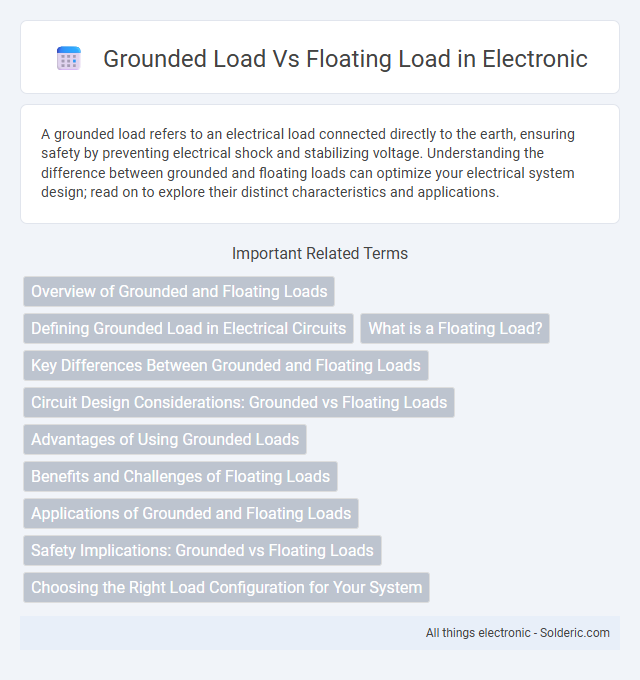A grounded load refers to an electrical load connected directly to the earth, ensuring safety by preventing electrical shock and stabilizing voltage. Understanding the difference between grounded and floating loads can optimize your electrical system design; read on to explore their distinct characteristics and applications.
Comparison Table
| Aspect | Grounded Load | Floating Load |
|---|---|---|
| Definition | Load referenced to earth ground or system neutral | Load isolated from ground, no direct reference to earth or neutral |
| Safety | Higher safety due to fault current path to ground | Lower safety risk of ground faults, but detection harder |
| Fault Detection | Easier; faults cause detectable ground currents | Harder; ground faults may go unnoticed without special sensors |
| Applications | Industrial power systems, residential wiring | Isolated communication circuits, sensitive equipment |
| System Complexity | Simpler grounding scheme | Requires isolation measures and monitoring devices |
| Noise Immunity | Lower; ground loops possible | Higher; reduced ground loop interference |
| Cost | Generally lower installation and maintenance cost | Higher due to isolation and monitoring requirements |
Overview of Grounded and Floating Loads
Grounded loads are electrical loads connected directly to the system ground, ensuring a reference point for voltage stabilization and safety by limiting fault currents. Floating loads are isolated from ground, lacking a direct reference, which can reduce ground loop noise but may pose challenges in fault detection and safety. Understanding the distinction between grounded and floating loads is critical in electrical system design for optimizing performance and maintaining protection standards.
Defining Grounded Load in Electrical Circuits
Grounded load in electrical circuits refers to a load connected directly to the ground or earth, providing a reference point of zero voltage, which enhances safety and reduces electrical noise. This configuration ensures stable voltage levels by allowing excess current to safely dissipate into the earth, minimizing the risk of electric shock or equipment damage. Understanding grounded load characteristics helps you design safer and more reliable electrical systems.
What is a Floating Load?
A floating load refers to an electrical load that is not connected directly to the ground or earth reference point, allowing voltage potential relative to ground to vary. This type of load is common in isolated circuits or systems where the return path is not fixed, often resulting in less noise and interference compared to grounded loads. Floating loads are frequently used in medical devices, measurement instruments, and sensitive electronics to improve signal integrity and safety.
Key Differences Between Grounded and Floating Loads
Grounded loads have a direct connection to the earth or a reference point, providing a stable and consistent voltage reference, which enhances safety and reduces electrical noise. Floating loads lack this direct connection, resulting in potential voltage instability and increased susceptibility to noise and interference. Understanding these differences ensures your electrical system's reliability and protects sensitive equipment from voltage fluctuations.
Circuit Design Considerations: Grounded vs Floating Loads
Grounded loads connect directly to the system ground, providing a stable reference during circuit operation and simplifying fault detection and protection design. Floating loads, isolated from ground, require careful insulation and monitoring to prevent potential voltage imbalances and ensure safety in ungrounded systems. Your circuit design must consider these differences to optimize reliability, safety, and performance in varied electrical environments.
Advantages of Using Grounded Loads
Grounded loads enhance electrical safety by providing a clear path for fault currents, reducing the risk of electric shock and equipment damage. They ensure more stable voltage levels and improve system reliability by minimizing transient overvoltages. Grounded loads also facilitate easier detection and isolation of faults, leading to more efficient maintenance and reduced downtime.
Benefits and Challenges of Floating Loads
Floating loads provide enhanced flexibility and isolation from ground loops, reducing noise and interference in sensitive electronic circuits. They enable safer operation in environments where direct grounding may cause potential differences or hazardous conditions. However, challenges include the need for careful insulation design and increased complexity in fault detection due to the absence of a direct reference to ground.
Applications of Grounded and Floating Loads
Grounded loads are commonly used in residential and commercial electrical systems where safety and stable reference points are critical for devices like lighting and appliances. Floating loads are preferred in specialized applications such as medical equipment, instrumentation, and aerospace systems where isolation from ground helps reduce electrical noise and improve signal integrity. Your choice between grounded and floating loads depends on the need for safety, noise reduction, and system performance in specific environments.
Safety Implications: Grounded vs Floating Loads
Grounded loads provide a direct path to earth, minimizing the risk of electric shock and equipment damage by safely dissipating fault currents. Floating loads, lacking a reference to ground, pose a higher safety risk due to potential voltage buildup, increasing the chance of shock hazards and insulation breakdown. Proper grounding practices are essential to ensure electrical safety and prevent accidental energization in grounded versus floating load systems.
Choosing the Right Load Configuration for Your System
Choosing the right load configuration depends on your system's grounding requirements and safety standards. Grounded loads provide a direct connection to the earth, enhancing protection against electrical faults and reducing electromagnetic interference. Floating loads, isolated from ground, offer flexibility for sensitive equipment and minimize ground loop issues, making them ideal for applications requiring noise reduction and signal integrity.
grounded load vs floating load Infographic

 solderic.com
solderic.com